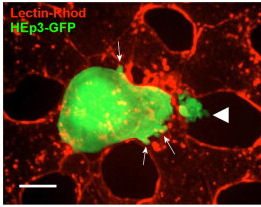Invadopodia Are Required for Cancer Cell Extravasation and Are a Therapeutic Target for Metastasis

Cell Rep. 2014 Sep 11;8(5):1558-70. doi: 10.1016/j.celrep.2014.07.050. Epub 2014 Aug 28.
Leong HS1, Robertson AE1, Stoletov K2, Leith SJ1, Chin CA1, Chien AE1, Hague MN3, Ablack A1, Carmine-Simmen K2, McPherson VA1, Postenka CO3, Turley EA4, Courtneidge SA5, Chambers AF3, Lewis JD6.
Abstract
Tumor cell extravasation is a key step during cancer metastasis, yet the precise mechanisms that regulate this dynamic process are unclear. We utilized a high-resolution time-lapse intravital imaging approach to visualize the dynamics of cancer cell extravasation in vivo. During intravascular migration, cancer cells form protrusive structures identified as invadopodia by their enrichment of MT1-MMP, cortactin, Tks4, and importantly Tks5, which localizes exclusively to invadopodia. Cancer cells extend invadopodia through the endothelium into the extravascular stroma prior to their extravasation at endothelial junctions. Genetic or pharmacological inhibition of invadopodia initiation (cortactin), maturation (Tks5), or function (Tks4) resulted in an abrogation of cancer cell extravasation and metastatic colony formation in an experimental mouse lung metastasis model. This provides direct evidence of a functional role for invadopodia during cancer cell extravasation and distant metastasis and reveals an opportunity for therapeutic intervention in this clinically important process.
